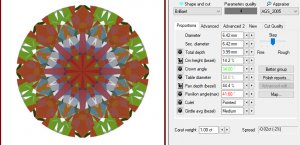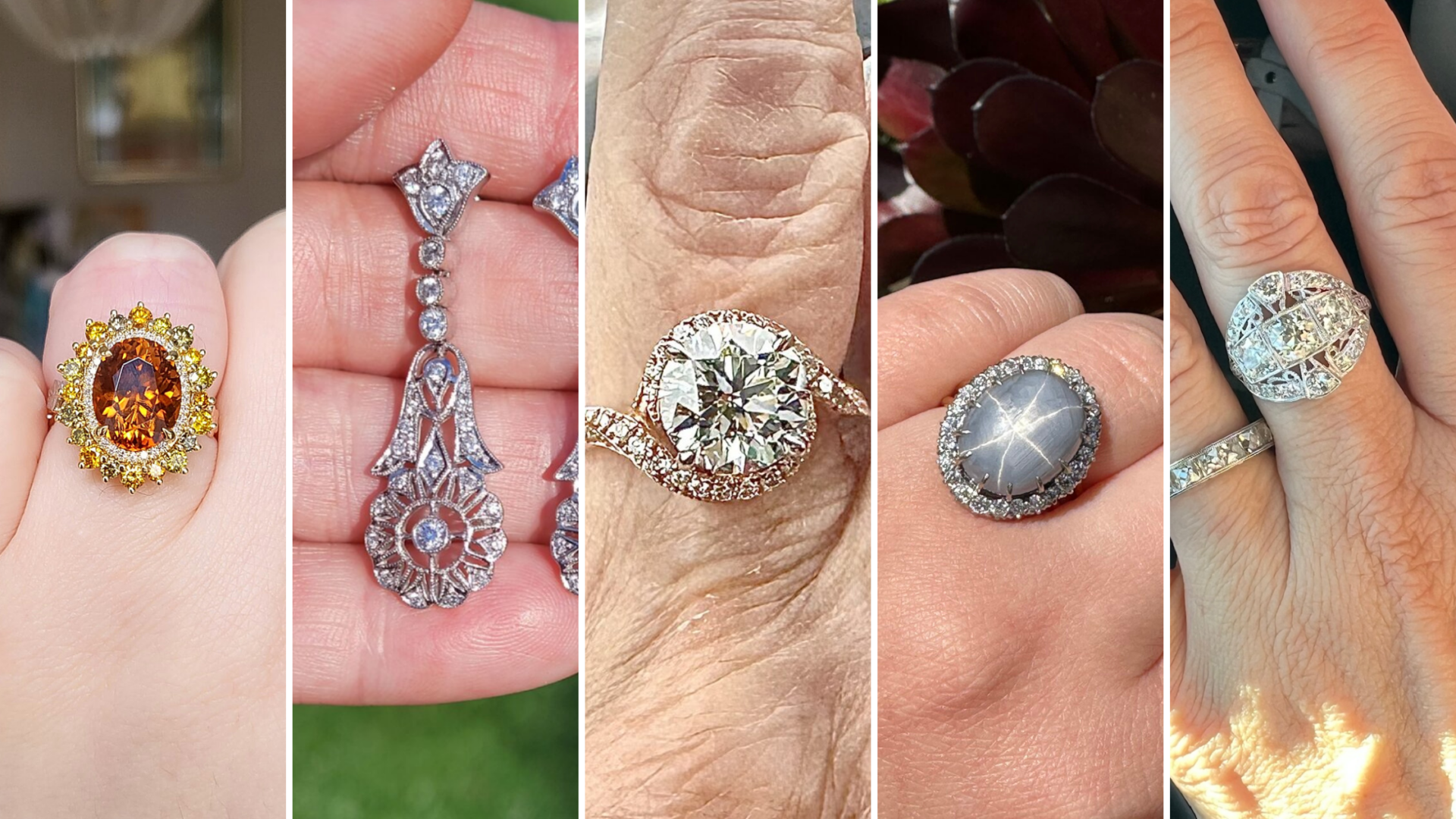The6ixontherun
Rough_Rock
- Joined
- Jul 3, 2017
- Messages
- 36
What do the PS crew think of the difference between TIC and BIC, which is the better of the two?!
I do not mind crowns down to 33 if pavilion is 41. HCA seems to like 33/41 too with a few that I popped in there (even seen some with scores <1), AGS tables too. Of course ASET or some sort of light imaging would be most helpful no matter what combo is picked.This is best:
These are measurements to help you stay in ideal cut territory with a GIA excellent cut stone.
table: 54-58
depth: 60-62.3
crown angle: 34-35.0 (up to 35.5 crown angle can sometimes work with a 40.6 pav angle)
pavilion angle: 40.6-40.9 (sometimes 41.0 if the crown angle is close to 34)
Indeed, it's a borderline area. Predicted as AGS 1-2 with smaller tables because brightness and fire are potentially both reduced. Increasing table size to 59-60% will increase brightness enough to bring the prediction back into the AGS 0 range (cut guides for 57T below, used with permission).I do not mind crowns down to 33 if pavilion is 41. HCA seems to like 33/41 too with a few that I popped in there (even seen some with scores <1), AGS tables too.
100% correct. In fact, the HCA has no idea about any actual diamond's minor facet choices or optical precision. Pairing combos like the above with short lower-halves would lower the AGS performance result. Meanwhile, smart choices and precise cutting could improve it.Of course ASET or some sort of light imaging would be most helpful no matter what combo is picked.

This is best:
These are measurements to help you stay in ideal cut territory with a GIA excellent cut stone.
table: 54-58
depth: 60-62.3
crown angle: 34-35.0 (up to 35.5 crown angle can sometimes work with a 40.6 pav angle)
pavilion angle: 40.6-40.9 (sometimes 41.0 if the crown angle is close to 34)
Indeed, it's a borderline area. Predicted as AGS 1-2 with smaller tables because brightness and fire are potentially both reduced. Increasing table size to 59-60% will increase brightness enough to bring the prediction back into the AGS 0 range (cut guides for 57T below, used with permission).
100% correct. In fact, the HCA has no idea about any actual diamond's minor facet choices or optical precision. Pairing combos like the above with short lower-halves would lower the AGS performance result. Meanwhile, smart choices and precise cutting could improve it.

Pavilion angle is critical. The main pavilion facets are the engine of performance and 41.6 (average angle of all pavilion mains) is too high.Question I found a diamond with the following:
Depth 62.1
Table 58
CA 34
PA 41.6
Only the PA is a little off your grid but yet the diamond rated a 5.7 on the HCA scale, how did that happen?
Pavilion angle is critical. The main pavilion facets are the engine of performance and 41.6 (average angle of all pavilion mains) is too high.
Logical question.Question I found a diamond with the following:
Depth 62.1
Table 58
CA 34
PA 41.6
Only the PA is a little off your grid but yet the diamond rated a 5.7 on the HCA scale, how did that happen?

Logical question.
(1) The Pavilion Angle describes the most important and sensitive facet group. Those pavilion mains are the "engines" driving light return. A movement of even 0.1 degree there can make a big difference.
Practical example: Here's a simulation of those measurements. The white area under the table is allowing light to pass through the diamond, and will be dark in many conditions. That's a result of the steep pavilion mains with that table and crown combo.

(2) Supplemental info: Be advised the above image shows a "best case" scenario. The simulation is a perfect-wireframe. There are actually 8 pavilion main facets (as well as 8 crown, 8 star, 16 upper and 16 lower halves) but the single numbers on grading reports are an average of each facet group's measurements. There's no way to know how consistent they have been polished without more info, such as an ideal-scope or ASET image.
I wouldn't say PS people don't like them. It's a matter of taste.Thank you for the reply... so how come PS people don't like 60% tables if having a 60% table still rates high in the HCA?

The6,
Just to let you know that trade members here are not permitted to recommend or criticize other vendors diamonds. We can answer questions and discuss general information to help you better understand how to make better choices. For instance, understanding general concepts like light performance or how best use tools such as HCA are very much open topics. We can discuss certain aspects of a given diamond image or lab report, to help you further understand it.
Having said that, there are many knowledgeable consumers here who are very helpful and they are free to give their opinions on specific stones.
* Trade members can be identified by the trade badge in the upper right hand corner of the post
My pleasure. Be sure to have fun as you explore all of these.Hi John,
Thank you for your knowledge!
Could I ask your opinion on a couple diamonds?
1) GIA # 1249171668: 60-60 (60-58 actually). Groovy. The SI2 on dossier report means we no inclusion plot. And be sure your definition of eye-clean matches up with the seller's. With this make it's also worth an inquiry about the 75% lower halves. see this post: Experts please help me decide between these two...
2) GIA # 7248676565: 41.6 PA. See information in posts above.
3) GIA # 5182425080: Another technical 60-60, though the table and lowers lean it toward ideal. Same inquiry to someone who has the diamond about the 75% lower halves.
4) GIA # 6241101998: Ideal make. The CA stipulates 35 degrees, but remember GIA rounds those numbers to nearest 0.5. The difference between 34.8 and 35.2, paired with the given table and pavilion, would technically be AGS0 candidate to AGS2 candidate. So it's worth an inquiry, if that matters to you (it may not).
Much above worth pursuing... The grading report info is good to have, but if you're looking for detailed analysis (you sound like a detail-person) you'll need to get ideal-scope or ASET images. They reveal far more than averaged numbers on a report. Especially considering the rounding.
Your help is greatly appricated
Hi Bryan. Not intending to create waves. I just reported my own post above.The6,
Just to let you know that trade members here are not permitted to recommend or criticize other vendors diamonds...
Hi Bryan. Not intending to create waves. I just reported my own post above.
By way of explanation:
<< Hello. I haven't posted in a while . The last time I was posting here with regularity trade members were able to answer questions if the seller had not been specifically identified. If that's no longer permitted please let me know and delete my post. Many thanks. JP >>
Yes, just be a little patient. I am certain some folks will come on and give you some advice.Is there any consumers that are able to give me an idea which of the 4 I should pursue, trying to narrow my search down to two.
Tip of the hat Bryan. I truly appreciate your comment, and will try to keep this wormhole open...lately I seem to have discovered some 25-hour days.I am sure I am not alone here is saying I am happy to see posting again JP. Your methodical, easy to understand explanations are a blessing for consumers looking to get up to speed around their diamond search, and for prosumers looking to further develop their knowledge.
And, as I can attest from personally, for other professionals who come here looking to up their game!
You young mavericks, with your rabble-rousing ways.Didn't mean to cause an issue haha
Hi John,
Thank you for your knowledge!
Could I ask your opinion on a couple diamonds?
1) GIA # 1249171668
2) GIA # 7248676565
3) GIA # 5182425080
4) GIA # 6241101998
Your help is greatly appricated
1) Shallow/steep CA/PA combo here. I'd be wanting to see the stone if an image or video is available. I'm usually not a fan of stones where table percentage is higher than the entire depth of the stone. GIven it's SI2, a vid would also help to determine how bad the inclusions are and where they are located. Could be eye-clean for all we know.
2) PA waaaay too high.
3) Might be a contender if the CA is actually closer to 33.75 degrees given the rounding issue with CA's on GIA reports.
4) Now we're getting into territory which is what I prefer. If the CA is actually between 34.75-35 degrees, we're into superideal territory with this stone. No issues with fluorescence being faint (might even score a small discount on the stone because of it) and only clarity grading characteristic is a feather (would be curious as to where the feather/s is/are located). Video of the stone would definitely help out.
Of these four you've provided the GIA report numbers to us, #4 would be my first pick followed closely by #3 (but this is all subject to seeing what the stones actually look like).
GIA uses the same scanners as other labs. It's not a matter of capability.@John Pollard, is there any particular reason why GIA rounds off CA's to the nearest 0.5 degree given that other labs that we PS-ers hold to the same esteem (like AGS, some would also say HRD) plus others that we don't hold to the same esteem (like EGL, GSI and the many other labs that grade much more leniently) seem to be able to provide diamond spec data that has CA's to the nearest 0.1 degree?
Despite GIA seeming to have the cachet around the world of being the foremost diamond grading lab, why on earth can't they report crown angles, star facet percentages and LGF percentages more accurately than other labs? I'm more inclined to purchase stones graded by AGS because I know what I'm actually getting whereas with GIA graded stones, I will have to take the proportions with a grain of diamond dust.
Scan technology has given error. Even lab scans stipulate accuracy at +/- 10 microns linear and +/- 0.1 degree angular.
